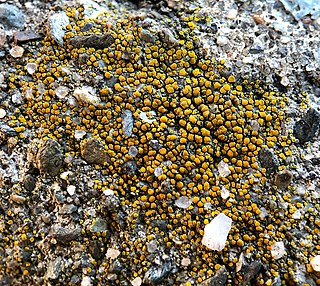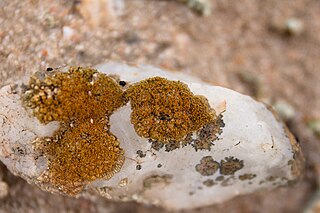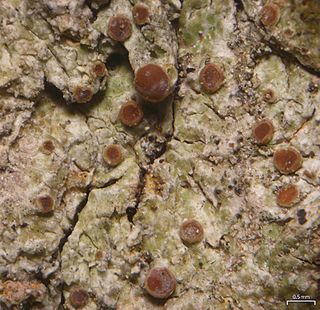
The Teloschistaceae are a large family of mostly lichen-forming fungi belonging to the class Lecanoromycetes in the division Ascomycota. The family has a cosmopolitan distribution, although members occur predominantly in subtropical and temperate regions. Most members are lichens that either live on rock or on bark, but about 40 species are lichenicolous – meaning they are non-lichenised fungi that live on other lichens. Many members of the Teloschistaceae are readily identifiable by their vibrant orange to yellow hue, a result of their frequent anthraquinone content. The presence of these anthraquinone pigments, which confer protection from ultraviolet light, enabled this group to expand from shaded forest habitats to harsher environmental conditions of sunny and arid ecosystems during the Late Cretaceous.

Flavoplaca is a genus of crust-like or scaly lichens in the family Teloschistaceae. It has 28 species with a mostly Northern Hemisphere distribution.

Xanthocarpia is a genus of mostly crustose lichens in the family Teloschistaceae. It has 12 species with a largely Northern Hemisphere distribution.

Squamulea is a genus of lichen-forming fungi in the family Teloschistaceae. It has 15 species. The genus was circumscribed in 2013 by Ulf Arup, Ulrik Søchting, and Patrik Frödén, with Squamulea subsoluta assigned as the type species. Five species were included in the original account of the genus. The genus name alludes to the squamulose growth form of most of its species. Squamulea has a worldwide distribution; when the genus was originally created, the centre of distribution was thought to be in southwestern North America.
Sirenophila is a genus of crustose lichens in the subfamily Teloschistoideae of the family Teloschistaceae. It has four species with an Australasian distribution.
Huneckia is a genus of crustose lichens in the subfamily Caloplacoideae of the family Teloschistaceae. It has four species.

Wetmoreana is a genus of lichen-forming fungi in the family Teloschistaceae. It has two crustose, saxicolous (rock-dwelling) species.
Catenarina is a genus of lichen-forming fungi in the family Teloschistaceae consisting of three species. These crustose lichens are characterized by their reddish-brown pigmentation and the presence of the secondary compound 7-chlorocatenarin. The genus is found in the southernmost regions of the Southern Hemisphere, including Antarctica, southern Patagonia, and the Kerguelen Islands.

Xanthocarpia feracissima is a species of saxicolous, crustose lichen in the family Teloschistaceae. It was first formally described as a new species in 1953 by Swedish lichenologist Adolf Hugo Magnusson, as a member of the genus Caloplaca. The type specimen was collected in 1939 by John Walter Thomson in Lake Koshkonong, Wisconsin. In the original description, Magnusson notes a similarity to the lichen now known as Gyalolechia flavovirescens, but distinguishes the new species by its lack of a visible thallus, the sordid-reddish color of its discs, and the "unusually narrow" septa of the spores. Patrik Frödén, Ulf Arup, and Ulrik Søchting transferred the taxon to Xanthocarpia in 2013, following molecular phylogenetic analysis of the family Teloschistaceae.

Stellarangia is a genus of lichen-forming fungi in the family Teloschistaceae. It has three species of saxicolous (rock-dwelling), crustose lichens. Species of Stellarangia are found in dry, desert areas in Namibia and South Africa.
Teuvoahtiana is a genus of lichen-forming fungi in the family Teloschistaceae. It contains three species of saxicolous (rock-dwelling), crustose lichens, all of which occur in South America.
Caloplaca nigra is a species of saxicolous (rock-dwelling), crustose lichen in the family Teloschistaceae. Found on rocks predominantly in the Galápagos Islands, it is characterised by its dark reproductive structures.
Follmannia is a genus of lichen-forming fungi in the family Teloschistaceae. It has three species. All three species are crustose lichens, and all occur in South America.
Haloplaca is a genus of lichen-forming fungi in the subfamily Teloschistaceae of the family Teloschistaceae. It contains three species of crustose lichens. The genus was circumscribed by Ulf Arup and colleagues in 2013, with Haloplaca britannica assigned as the type species. The genus name alludes to the preference of its species for salt-rich environments. All three species occur in the United Kingdom, but H. suaedae also occurs in Greece, Morocco and Turkey. Haloplaca species occur near the sea, either on rocks or on plant debris.

Obscuroplaca is a genus of lichen-forming fungi in the family Teloschistaceae. It contains three species of corticolous (bark-dwelling), crustose lichens.

Wetmoreana brouardii is a species of saxicolous (rock-dwelling), crustose lichen in the family Teloschistaceae.
Usnochroma is a genus of lichen-forming fungi in the family Teloschistaceae. It has two species of crustose lichens. The genus was circumscribed in 2013 by lichenologists Ulrik Søchting, Ulf Arup, and Patrik Frödén, with Usnochroma carphineum assigned as the type species. The genus name refers to the yellowish-green colour of the thallus, which is caused by the substance usnic acid. Usnochroma species occur in Macaronesia, South Africa, the Mediterranean Basin, and Algeria.
Caloplaca cupulifera is a widely distributed species of saxicolous (rock-dwelling), crustose lichen in the family Teloschistaceae. It has a chrome-yellow thallus with bright yellow cup-shaped soredia. Although originally described as a new species in 1915 and placed in the large genus Caloplaca in 1931, modern molecular phylogenetics suggests that its classification requires an update.

Flavoplaca oasis is a species of saxicolous (rock-dwelling), crustose lichen in the family Teloschistaceae. It is widely distributed across Europe, and has been reported in Western Asia, China, and North Africa.
Loekoesia is a genus of lichen-forming fungi in the family Teloschistaceae. It contains three species of saxicolous (rock-dwelling), crustose lichens. Collectively, the genus occurs in South Korea, Mauritius, and the United States. The genus is distinguished by its grey, crust-like thallus, which can be either whole or divided into patch-like segments. Loekoesia lichens have bright white, rounded soralia, which produce bluish to whitish powdery propagules (soredia) and are arranged in irregular groups on the thallus.









